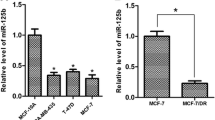Abstract
Purpose
Breast cancer is the most common invasive type of cancer among women. Role of different microRNAs (miRNAs) and poly(ADP-ribose) polymerases (PARPs) in breast cancer has been well established. This study aimed to explore the effects of miR-891b on sensitizing breast cancer cells to alkylating chemotherapeutic drugs through PARPs.
Methods
The expression of miR-891b and PARP1 in human breast cancer cells HCC1806 was overexpressed by transfection with their mimics or expressing vector. Then, the transfected cells were exposed to 40 µM N-methyl-N-nitro-N-nitrosoguanidine (MNNG) for 1 h. The correlation between miR-891b and PARP1 was detected by RT-qPCR, western blot, and dual-luciferase reporter assay. Besides, MTT assay and Annexin V assay were done to measure cell proliferation and apoptosis, respectively.
Results
PARP1 was a target of miR-891b, and it was negatively regulated by miR-891b. MiR-891b increased the sensitivity of the HCC1806 cells to the cytotoxic effects of MNNG through suppressing cell proliferation and increasing the percentage of apoptotic cells. Restoration of PARP1 activity in the HCC1806 cells led to loss of miR-891b mediated sensitivity of the HCC1806 cells to MNNG.
Conclusion
MiR-891b increases the sensitivity of the breast cancer cells (HCC1806) to the cytotoxic effects of the chemotherapeutic agent MNNG by suppressing the expression of PARP1.





Similar content being viewed by others
References
McGuire A et al (2015) Effects of age on the detection and management of breast cancer. Cancers (Basel) 7(2):908–929
McGuire S (2016) World Cancer Report 2014. Geneva, Switzerland: World Health Organization, International Agency for Research on Cancer, WHO Press, 2015. Adv Nutr 7(2):418–419
Cardoso F et al (2017) Research needs in breast cancer. Ann Oncol 28:208–217
Mustafa M et al (2013) Psychological interventions for women with metastatic breast cancer. Cochrane Database Syst Rev 6:CD004253
Gonzalez-Angulo AM, Morales-Vasquez F, Hortobagyi GN (2007) Overview of resistance to systemic therapy in patients with breast cancer. Adv Exp Med Biol 608:1–22
Kim JS et al (2014) MicroRNA-205 suppresses the oral carcinoma oncogenic activity via down-regulation of Axin-2 in KB human oral cancer cell. Mol Cell Biochem 387(1–2):71–79
Diab M et al (2016) The role of microRNAs in the diagnosis and treatment of pancreatic adenocarcinoma. J Clin Med 5(6):59
Zhang B et al (2007) microRNAs as oncogenes and tumor suppressors. Dev Biol 302(1):1–12
Meltzer PS (2005) Cancer genomics: small RNAs with big impacts. Nature 435(7043):745–746
Riaz M et al (2013) miRNA expression profiling of 51 human breast cancer cell lines reveals subtype and driver mutation-specific miRNAs. Breast Cancer Res 15(2):R33
Livraghi L, Garber JE (2015) PARP inhibitors in the management of breast cancer: current data and future prospects. BMC Med 13:188
Rouleau M et al (2010) PARP inhibition: PARP1 and beyond. Nat Rev Cancer 10(4):293–301
Shi Wei et al (2016) MiR-449a promotes breast cancer progression by targeting CRIP2. Oncotarget 7(14):18906–18918
Fang H et al (2017) miRNA-21 promotes proliferation and invasion of triple-negative breast cancer cells through targeting PTEN. Am J Transl Res 9(3):953
He J et al (2017) miR-597 inhibits breast cancer cell proliferation, migration and invasion through FOSL2. Oncol Rep 37(5):2672–2678
Rodriguez-Barrueco R et al (2017) miR-424(322)/503 is a breast cancer tumor suppressor whose loss promotes resistance to chemotherapy. Genes Dev 31(6):553–566
Zhao G, Li Y, Wang T (2017) Potentiation of docetaxel sensitivity by miR-638 via regulation of STARD10 pathway in human breast cancer cells. Biochem Biophys Res Commun 487:255–261
Fan X et al (2017) MiR-199a-3p enhances breast cancer cell sensitivity to cisplatin by downregulating TFAM (TFAM). Biomed Pharmacother 88:507
Hakme A et al (2008) The expanding field of poly(ADP-ribosyl)ation reactions. ‘Protein Modifications: beyond the Usual Suspects’ Review Series. EMBO Rep 9(11):1094–1100
Schreiber V et al (2006) Poly(ADP-ribose): novel functions for an old molecule. Nat Rev Mol Cell Biol 7(7):517–528
Megnin-Chanet F, Bollet MA, Hall J (2010) Targeting poly(ADP-ribose) polymerase activity for cancer therapy. Cell Mol Life Sci 67(21):3649–3662
Helleday T (2011) The underlying mechanism for the PARP and BRCA synthetic lethality: clearing up the misunderstandings. Mol Oncol 5(4):387–393
Murai J et al (2012) Trapping of PARP1 and PARP2 by clinical PARP inhibitors. Cancer Res 72(21):5588–5599
Belleannee C et al (2012) Role of microRNAs in controlling gene expression in different segments of the human epididymis. PLoS One 7(4):e34996
Dong Q et al (2016) MicroRNA-891b is an independent prognostic factor of pancreatic cancer by targeting Cbl-b to suppress the growth of pancreatic cancer cells. Oncotarget 7(50):82338–82353
Durkacz BW et al (1980) (ADP-ribose)n participates in DNA excision repair. Nature 283(5747):593–596
Banasik M et al (1992) Specific inhibitors of poly(ADP-ribose) synthetase and mono(ADP-ribosyl)transferase. J Biol Chem 267(3):1569–1575
AlHilli MM et al (2016) In vivo anti-tumor activity of the PARP inhibitor niraparib in homologous recombination deficient and proficient ovarian carcinoma. Gynecol Oncol 143(2):379–388
Rugo HS et al (2016) Adaptive randomization of veliparib–carboplatin treatment in breast cancer. N Engl J Med 375(1):23–34
Munroe M, Kolesar J (2016) Olaparib for the treatment of BRCA-mutated advanced ovarian cancer. Am J Health Syst Pharm 73(14):1037–1041
Author information
Authors and Affiliations
Contributions
SJX: protocol development, data collection, data analysis, and manuscript writing. CZ: protocol development, data collection, and data analysis. ZMJ: data collection and data analysis. XLW: data collection and data analysis. YH: data collection and data analysis. ZLY: protocol development and manuscript editing.
Corresponding author
Ethics declarations
Funding
This research did not receive any specific grant from funding agencies in the public, commercial, or not-for-profit sectors.
Conflict of interest
The authors of this study declare no conflicts of interest in this work.
Ethical approval
This article does not contain any studies with human participants or animals performed by any of the authors.
Rights and permissions
About this article
Cite this article
Xu, S., Zhao, C., Jia, Z. et al. Down-regulation of PARP1 by miR-891b sensitizes human breast cancer cells to alkylating chemotherapeutic drugs. Arch Gynecol Obstet 296, 543–549 (2017). https://doi.org/10.1007/s00404-017-4444-3
Received:
Accepted:
Published:
Issue Date:
DOI: https://doi.org/10.1007/s00404-017-4444-3




